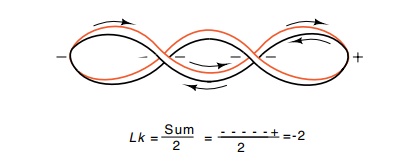Chapter: Genetics and Molecular Biology: Nucleic Acid and Chromosome Structure
Determining Lk, Tw, and Wr in Hypothetical Structures
Determining Lk,
Tw, and Wr in Hypothetical
Structures
A number of the fundamental processes in molecular
biology involve the binding and interactions of proteins with DNA, and the
covalent cutting and rejoining of DNA. Much insight into these processes is
provided by learning whether a portion of the DNA duplex is melted, and how the
cutting and rejoining is performed. Often these processes affect the linking
number or twist of the DNA, and both can be measured before and after the reaction.
Then the effects of possible models on these numbers can be compared to
experimental results. The determi-nation of linking number, twist, and
superhelical turns in a structure can sometimes be tricky, and in the general
situation is a relatively difficult mathematical problem. At our level of
analysis, we can proceed

Figure
2.12 Example of a structure with zero
twist but a linking number of 2and hence containing two superhelical turns.
with straightforward approximations based on the
fact that the linking number is the number of times that one DNA strand
encircles the other. It is useful for this number to have a sign that is
dependent on the orientation of the strands. Therefore, to determine the linking
number of a structure, draw arrows on the two strands pointing in opposite
directions, for example, pointing in the 5’ to 3’ direction on each. At each
point where the two different strands cross, assign a + or - value dependent on
the orientation. If the upper strand at a crossover can be brought into
correspondence with the lower strand with a clockwise

rotation, assign a +; if a counterclockwise
rotation is required, assign a -. The linking number equals the sum of these
values divided by 2, as shown in Fig. 2.12.
Viewing the DNA duplex as a ribbon provides one way
to picture twist. Consider a straight line drawn perpendicular to the axis of
the ribbon and through both edges. The rotation of this line as it is moved
down the axis gives the twist. For a given structure, the writhing or
superhelical turns is most easily given by whatever value Wr must have to make Lk =
Tw + Wr.
Related Topics